Drainage - fixing the "boggy bits".
It's not glamorous and it's brutally hard work, but clearing out drainage channels is the kind of fun that childhood me dreamt of - mud, water, wellies and you can make as much mess as you like..
Can you spot the drainage channel? It is in there somewhere…
Four and a half hours later, it may be messy and look awful, but it is maintained.
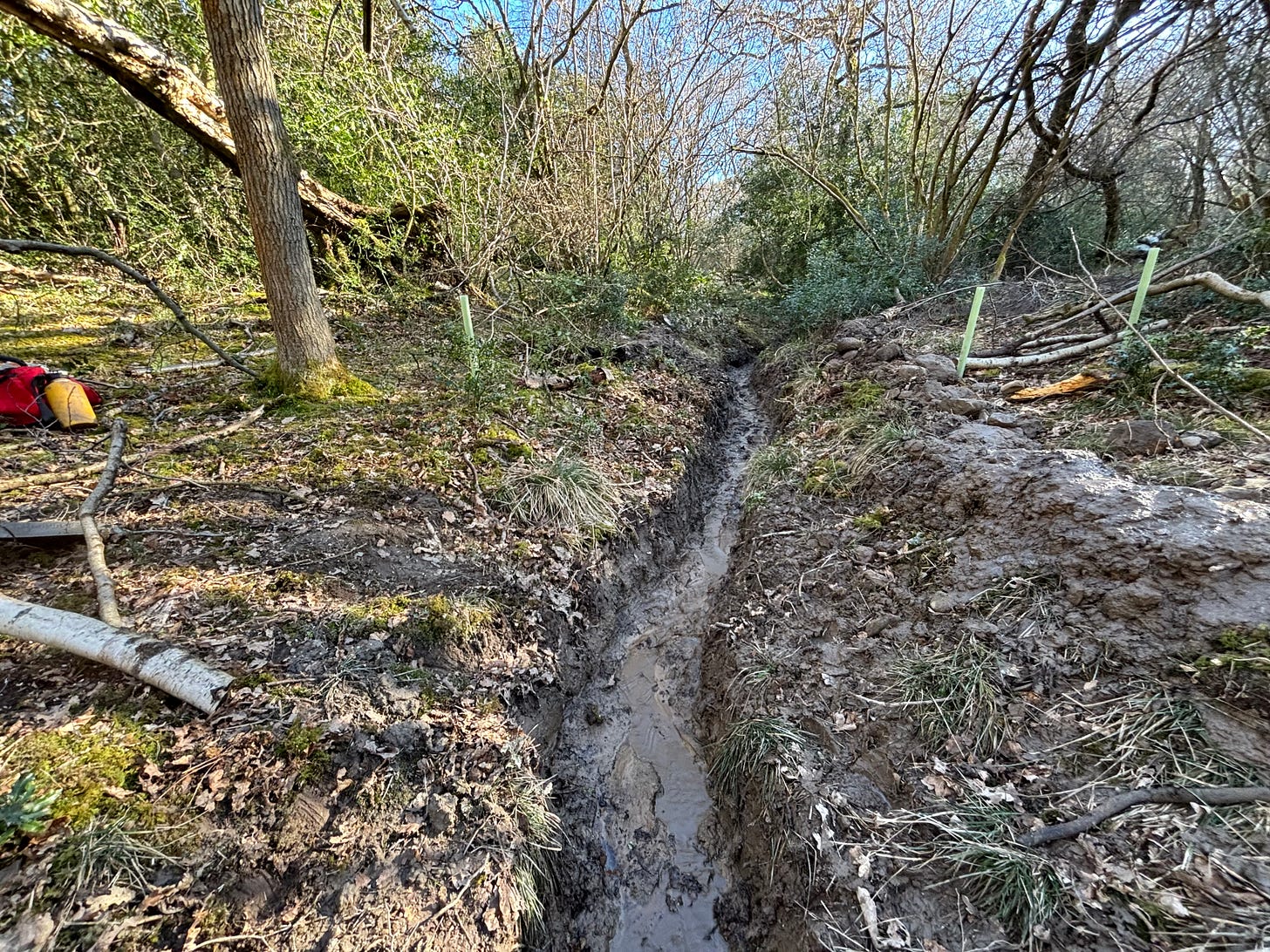
Today’s post is about digging wet, messy, muddy channels. Let’s start off with how it became to be this way.
Neglect
There are many parts of the woodland that are “boggy”. Typically seasonal, they normally dry up by early summer and remain dry until winter rains arrive. This is a natural part of the woodland cycle. Water comes, water goes. If you were to pay attention when you walk around the wood you can see make out what used to be defined drainage channels, but there’s one problem – no one has been taking care of them for decades and as a result, they’ve all silted up and become grassed over.
Don’t get me wrong, a woodland should have areas of water. Ponds (small or big) are especially beneficial for wildlife and the surrounding ecology. Everything in a woodland needs access to water for photosynthesis, transpiration and respiration, so having water on the site is essential. No water, no life. The problem though is that this woodland used to be well drained. If I had to guess, I’d say the drainage on my area of the wood was last managed about twenty years ago. So that’s twenty years of leaf litter, silt build up, deadwood and soil erosion all preventing the flow of water through the woodland.
As the water stops, flow slows down, it starts to back up and before you know it, it get’s boggy. In boggy ground roots struggle to respire aerobically and so they end up respiring anaerobically, which affects soil pH, which has the knock on effect of ending up hostile to the tree species that it used to be hospitable to. The trees get stressed, they end up being colonised by saprophytic fungi and eventually they die and fail. This is what the birch are doing.
This is a very long winded way of saying, the drainage situation needs to be fixed.
The problem areas
Here’s a crude screenshot of a map of the woodland (it clicks through to the actual map). It’s a little out of date (an updated map is in the works) but it shows four main features. Blue bits are the water courses that I knew about when I was making the map back in 2022. Pink shapes are “amenity areas” and the orange shapes are the “rides”. Note the burn that runs to the north of the map and the water course that was present at some point at the north west corner of the woodland.
The elevation of the site is that south drains to north and ultimately everything should end up in the burn (Stanley Burn) which you can see on the map. It probably did optimally drain into the burn at some point, but decades of non-management of the woodland has left everything less than optimal. As you can see from the blue bits on my map, that sub-optimal situation of yesterday is now my problem of today.
My primary aim with this woodland is to get it back to an oak standards with hazel coppice. I have somewhat started on that process with the planting of 900 hazels and 300 oaks, but before I invest any more time I need to solve the problem boggy areas because they’re only going to get worse. If you’re unsure of a what a coppice with standards is, then the below video tells all in ten minutes.
Management approach is a subject for a different post, but a large part of my work in the woodland is removing mature / over mature birches. The birch steal precious sun light from the hazel and they also crush the hazel when the birch inevitably fall over. But removing trees is not that straight forward. Logistically, I can only remove less than five cubic metres in a twelve week period because I don’t currently have a felling license for the site. Also, by removing a mature tree you inevitably create standing water situation…
A mature birch tree may use between 20,000 - 45,000 litres of water between April and October when the tree is photosynthesising and in “peak production”. The root systems serve as hydraulic pumps which pull water towards the roots. As water moves through soil it creates a path of least resistance which ultimately allows more water to move towards the tree. If you’re a tree, thats expecting to live for hundreds of years, that’s a great thing to happen. But when you remove trees, that water still travels to the roots of the tree, but without a trunk and canopy to pull the water from the ground, it pools. If that water has somewhere to go (drainage), no big deal, the pool drains and the little channels in the soil silt up and close. But, if the water has nowhere to drain to, it’s going to stay in place, get boggy and make my drainage issue worse.
The soil’s behaviour is like an inefficient algorithm — call it O(n²). - a situation in which the inputs work together to create slow, hard problem to solve.
Did I mention the draining needs fixing?
The Tools of Choice
Ideally, I’d be using a mini-digger for this task. Frankly, in the ideal world I’d own a mini-digger. However there are three reasons I cannot have a digger on this work. Firstly, I don’t have any vehicle capable of towing a plant trailer into the woodland (I sold the Ford Ranger), and secondly, there’s no way I can access this part of the woodland with a digger because the ground is too boggy. Thirdly, money – I cannot afford a mini/micro digger at this point in time. Watch this space though, it’s a necessary tool and as I age, it’s getting prioritised.
So, without a digger, I was working with hand tools and I was powered by pork pies.
The pies are essential, they’re very dense source of energy that you can devour in a few bites. Anyway, the tools…
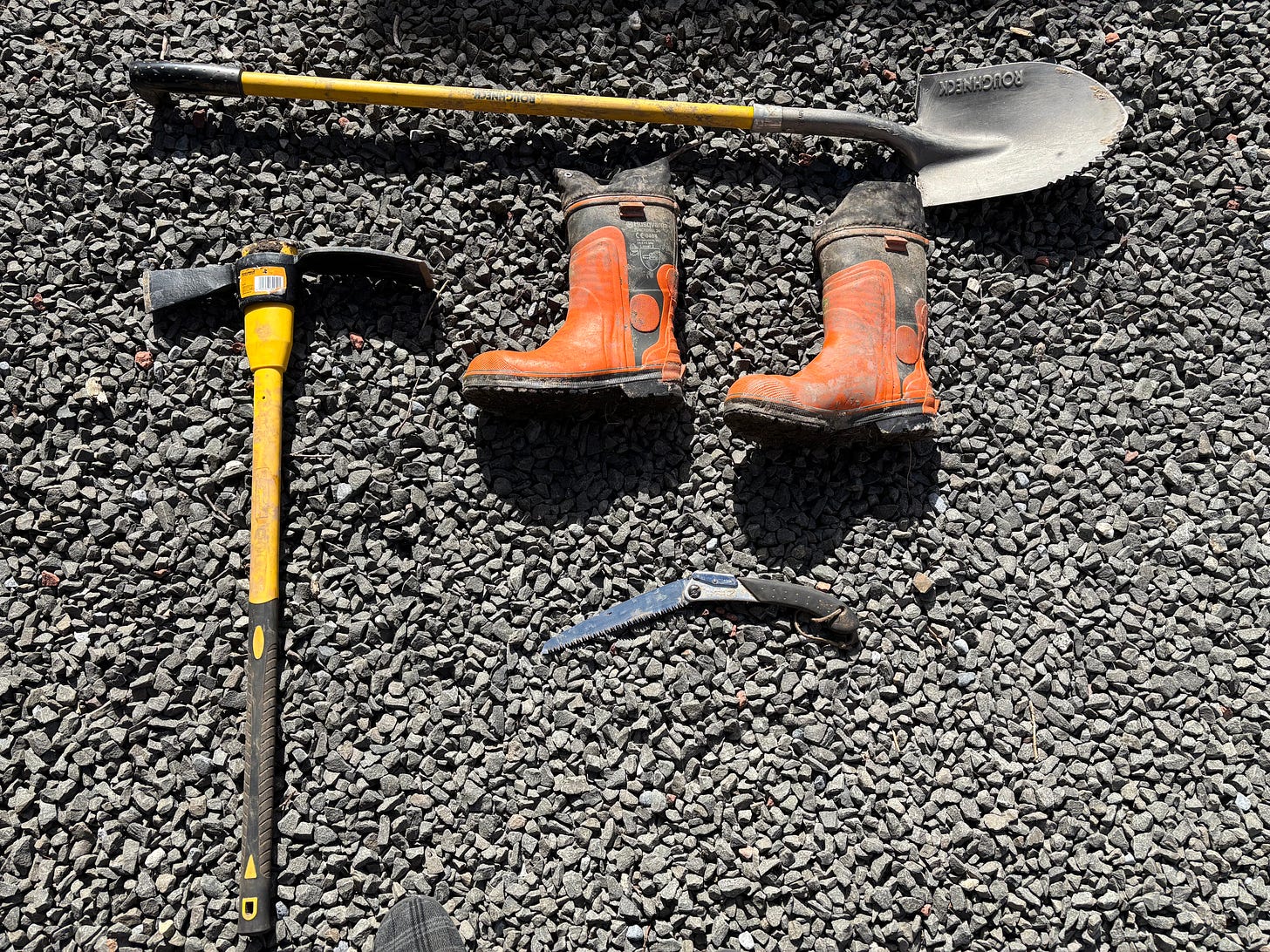
You don’t need much to get digging. The mattock is the main tool. It is the thing that does the digging, prying of rocks, chopping of roots and scraping of silt. The shovel (and yes, it is a shovel, not a spade) is for removing the earth to the sides of drainage. Wellies are optional, but they do prevent the feet staying soaking wet and making your books stink of anaerobic soil stank. My boots already smell bad enough with three years of sweat, there’s no need to add in soil stank into their aroma.
The Approach
Just jump in and start digging? Pretty much yes, but before you do, all of the tree related detritus needs to be removed and so you can swing your tools cleanly. Mattocks are great, but they are not axes or adzes, and whilst they’ll do a good job at getting through smaller roots, it’s pointless to use them to smash through roots in boggy water - these roots are best cut through with a silky.
Once you’re clean of roots and deadwood, it’s just a case of getting in there with the mattock, prying out all of the large rocks (precious resource) and putting them to one side, chopping up the silt so that you’re free to extract it with the shovel. Once it’s on the shovel, it’s flung onto the sides of the bank and I was using the deadwood as a barrier to stop it sliding back into the drains.
It is fun, but hard work and very satisfying. Here’s a little video of section that has been cleared looking onto a section that has not been cleared. Notice the 30cm of silted up leaf and deadwood “gank”. Notice how water flows through the bottom of that gank? That’s the cause of the upstream bogginess.
It’s just a case of clearing the stuff from the top, breaking up the ground with the mattock, prying out the rocks with the mattock, sawing the roots with the silky, breaking it back up with the mattock and then shovelling out the nutrient dense soily silt and putting it onto the banks where it’s held in place by logs of deadwood. Rinse and repeat.
After three hours I ended up with a nice section of about fifteen metres cleared and flowing nicely. It doesn’t look like much, but when the camera turns around you can get an idea of how much the flow has been improved. What I didn’t manage to capture on camera was the breaking through of a “head” of dammed up water. In some areas the larger rocks, twigs and leaf litter had created damns. When I broke through them, a large volume of water flowed the full width of the channel, and at a nice fast speed.
After four hours I had cleared about twenty five meters of drainage and I’m sure that this approach is going to make a dramatic difference on the drainage of the site. However, I don’t even think this section represents even one percent of the total that I have to do.
The Plan
I knew this would be a long burning exercise spanning at least one year. I suspect that in four hours I managed to do about twenty five metres.
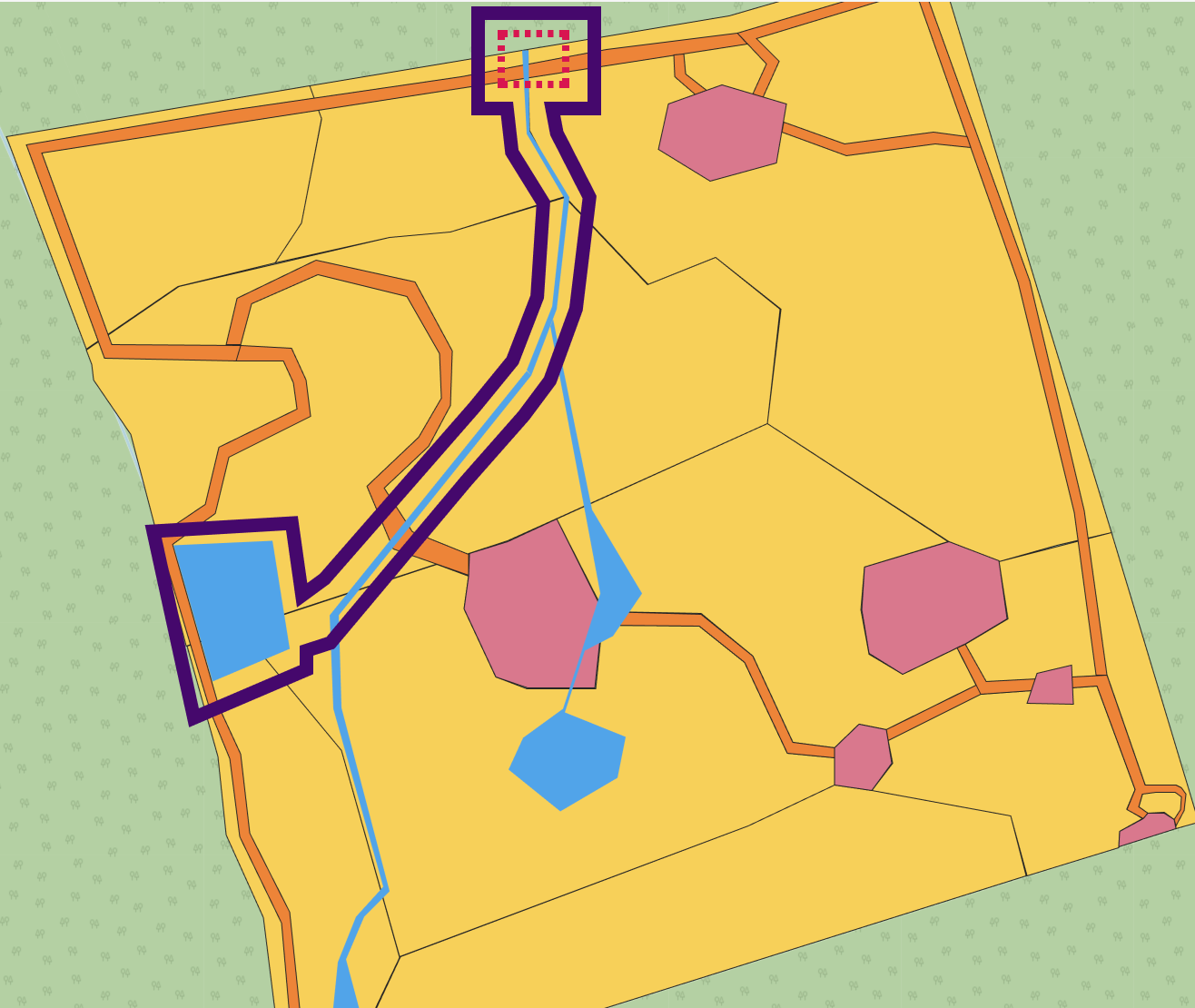
Above you can see the area that I managed to clear in four hours in the pink dotted rectangle. The larger purple shape is what I have to get done before July. I suspect that’ll take twenty - thirty days of digging. This section is the most important because it contains the most water, and thus represents the biggest chance to get the site draining. The large pool of water at left is almost certainly a spring from an old mine shaft (there is a tell tale iron oxide in it) and I suspect this is the biggest cause of downstream bogginess. Here’s a picture of the top of the area that shows some of the tell tale iron oxide.
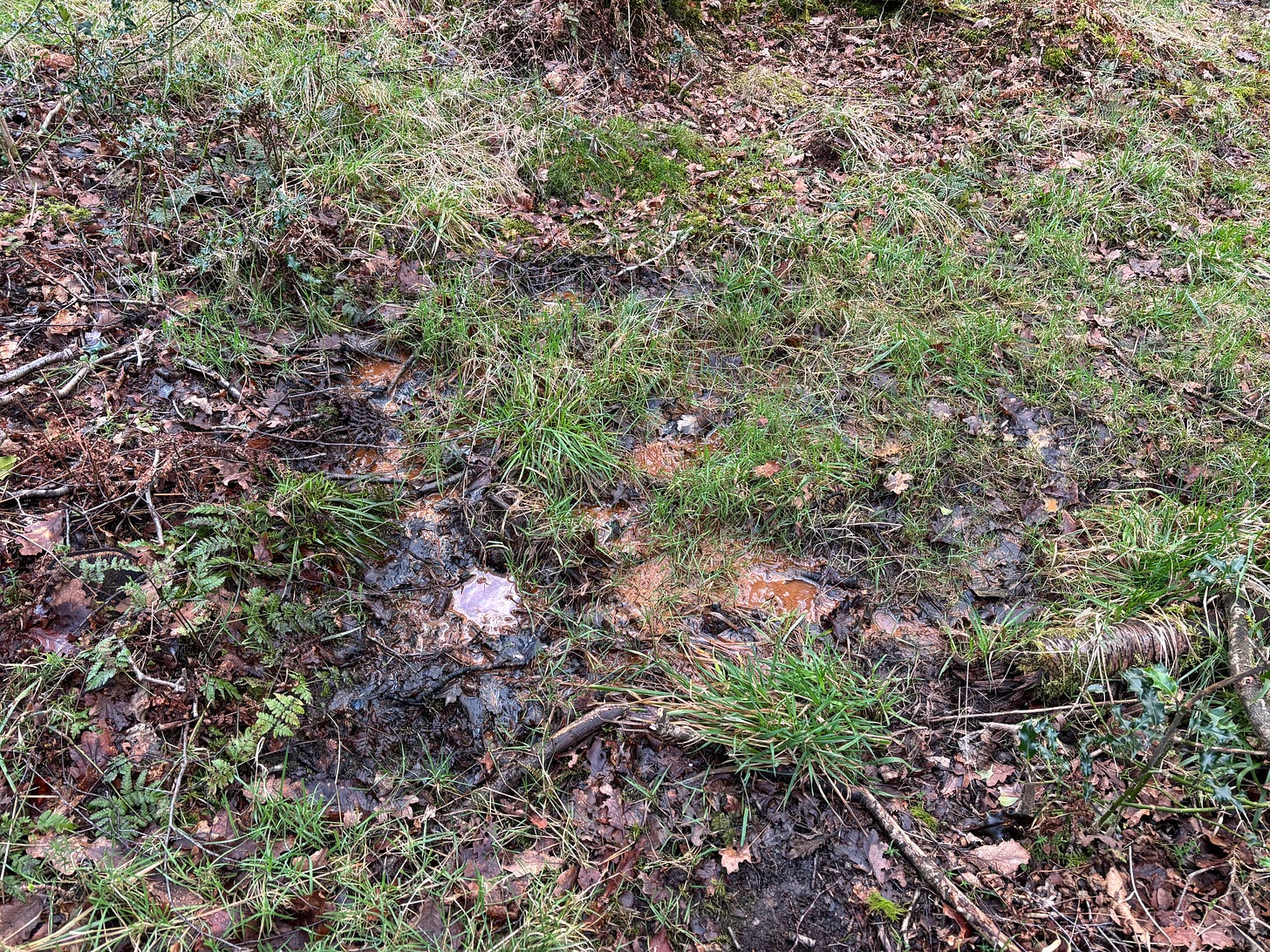
Here’s a plot twist, everything will will need digging out twice – once upstream and once downstream. What I’ve managed in this first pass is the tiny section of upstream, but as the water starts flowing more and more, it’s going to deposit a lot of silt into the areas that I’ve dug out already, so it’ll need another pass (albeit easier) to remove that silt build up.
As I move upstream I’m removing all the larger stones and putting them to the side on the banks. Once I’m done and all the way to the that pooled area on the left then I’ll start moving downstream clearing out the silt. This is easily done though, as the shovel as it’s nice and light; still though – it’s a pain in the anus.
However, that’s the future. If I’ve learned one thing from tree world it is not to get hung up on the big picture, focus on the next step that moves you closer to the end of your job. So how did I do?
Here’s before…
This is as far upstream as I got. Next time I will work through that holly thicket and up into an area that is very backed up and boggy.
You can see the thicket as the dark hole near the centre of the photo, but by this time I’d drained a lot of water out of this area.
It was very satisfying to see this channel fill up to about 30cm and then drain back down to 10cm when I broke through a head of water. I’d only cleared about twenty five metres, and I have the feeling that once I’ve connected everything up to the large area on the east, this is going to be a nice, seasonal, flowing body of water. Below, you can see border of my area of woodland in the line of tree tubes. It’s flowing nicely now.
The stuff that comes out is actually very high quality soil and nutritionally dense. It may look like slime (and it kind of is), but it is useful and I’m thinking I should probably be doing something a little more productive than throwing it to the sides of the bank. Mixed up 50/50 with decayed birch, it’d make fine potting compost for that future point in which there is actually a dedicated (and deer free) space to manage saplings.
I dug out about five metres into my neighbours property. I was in two minds about this, because obviously that’s not my property, but by the same token I didn’t want to just create a pool of water on the border that didn’t used to be there. About four metres into the neighbouring property there was an area of bog, so I basically connected this channel to that bog. Ideally, the owner should continue the drainage work, but people by these woodland plots for various reasons. Not everyone is interested in restoring their patch of woodland into an optimally productive and ecologically intact area. However, I am. So I dig.
There’s so much to do, but the thing (so I’ve been told) is that semi-ancient woodland doesn’t like sudden changes, so working slowly is fine. Lucky me.
I’ll be continuing this drainage work in the background and I’ll be spending at least one day a week on it every week until I’m at the large area on the east. But there’s also a tonne of other work to be doing, some of which is also digging. Starting with the area at the front of the woodland which I need to upgrade from a single space that fits one car into a full turning circle. Luckily, some of the stone from drainage will come in handy for retaining walls, which I’ll need to manage the left hand of this photo.

Thanks for reading,
I appreciate your attention.
Cheers,
Jamie



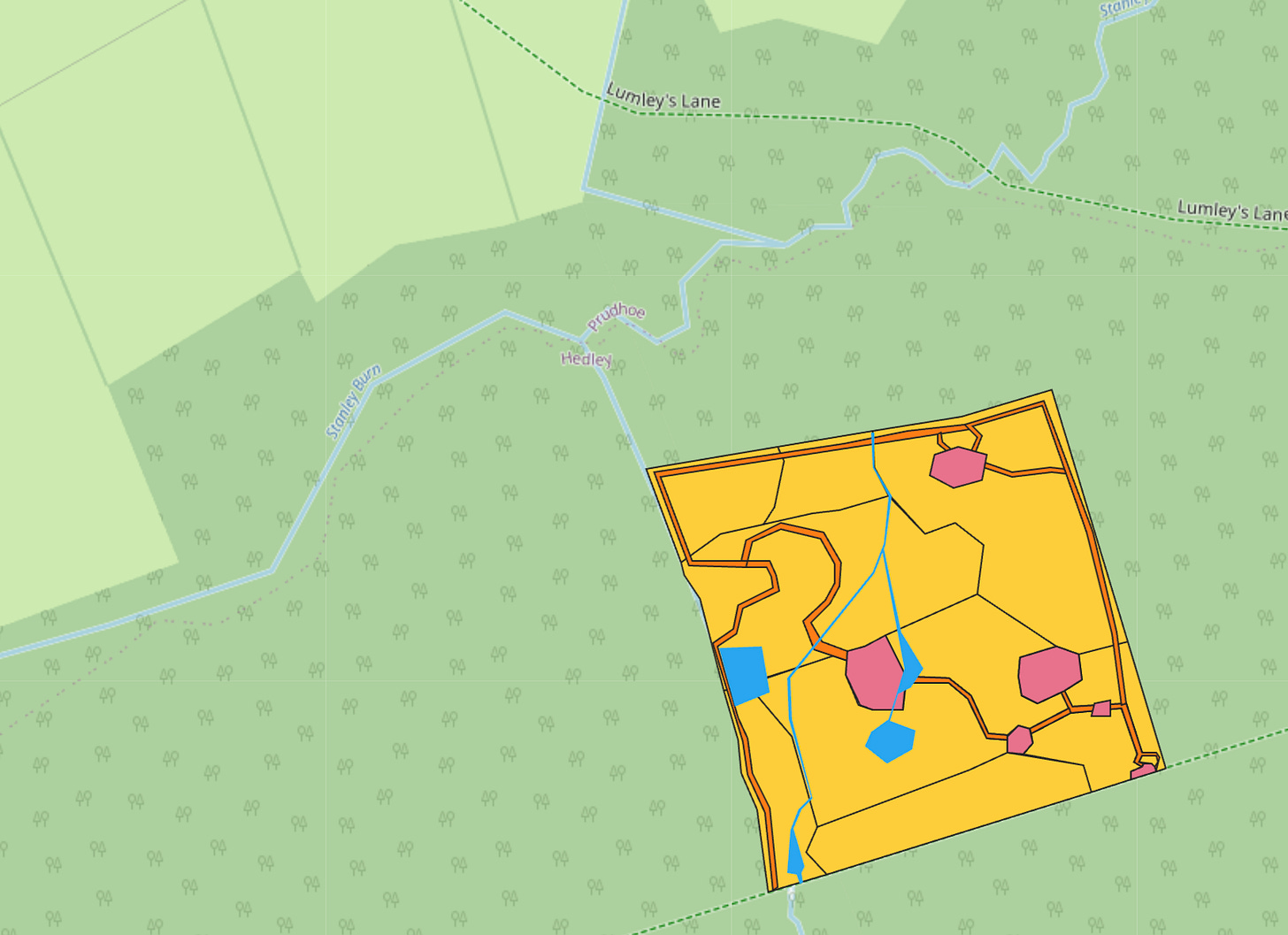

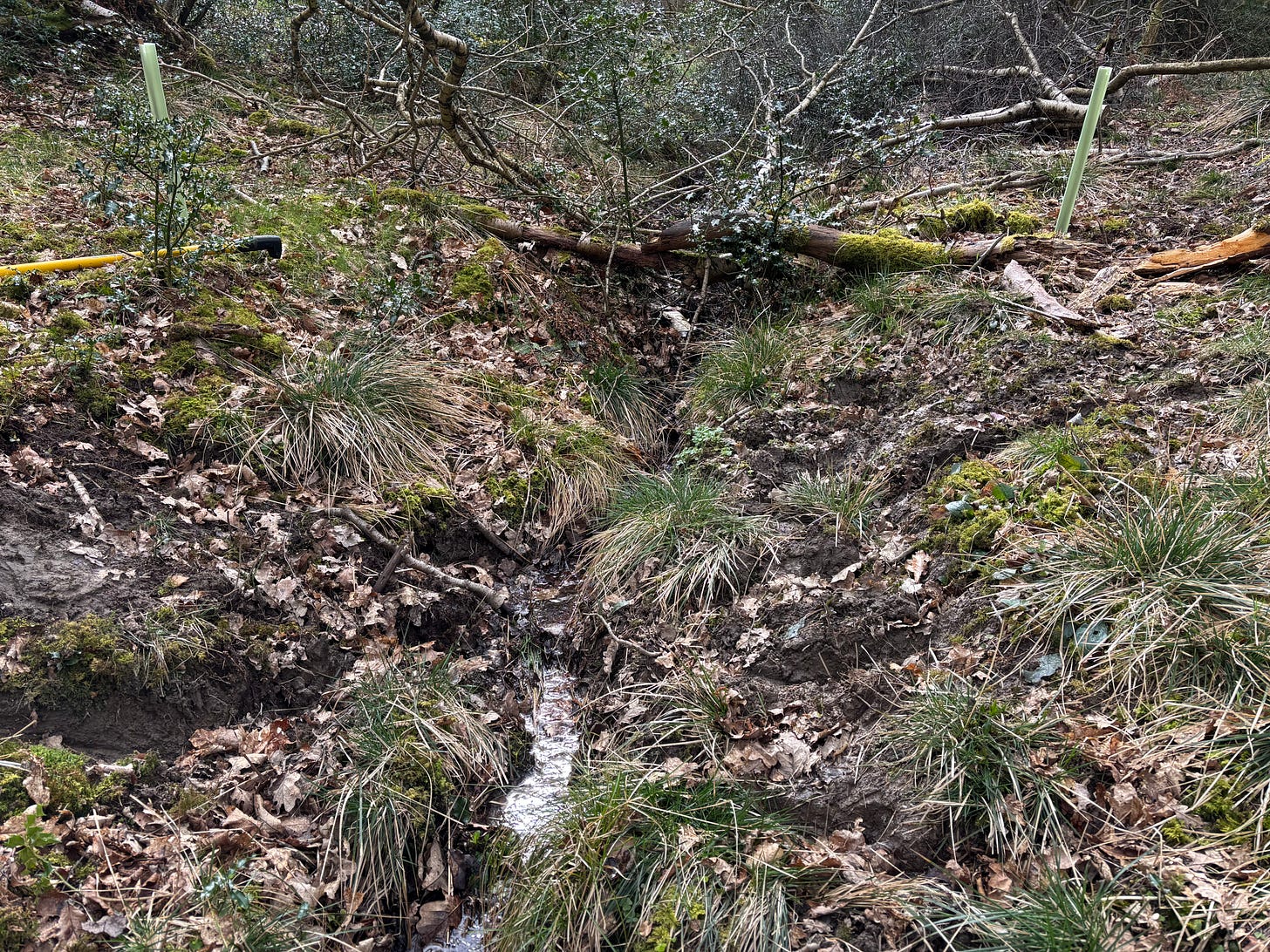
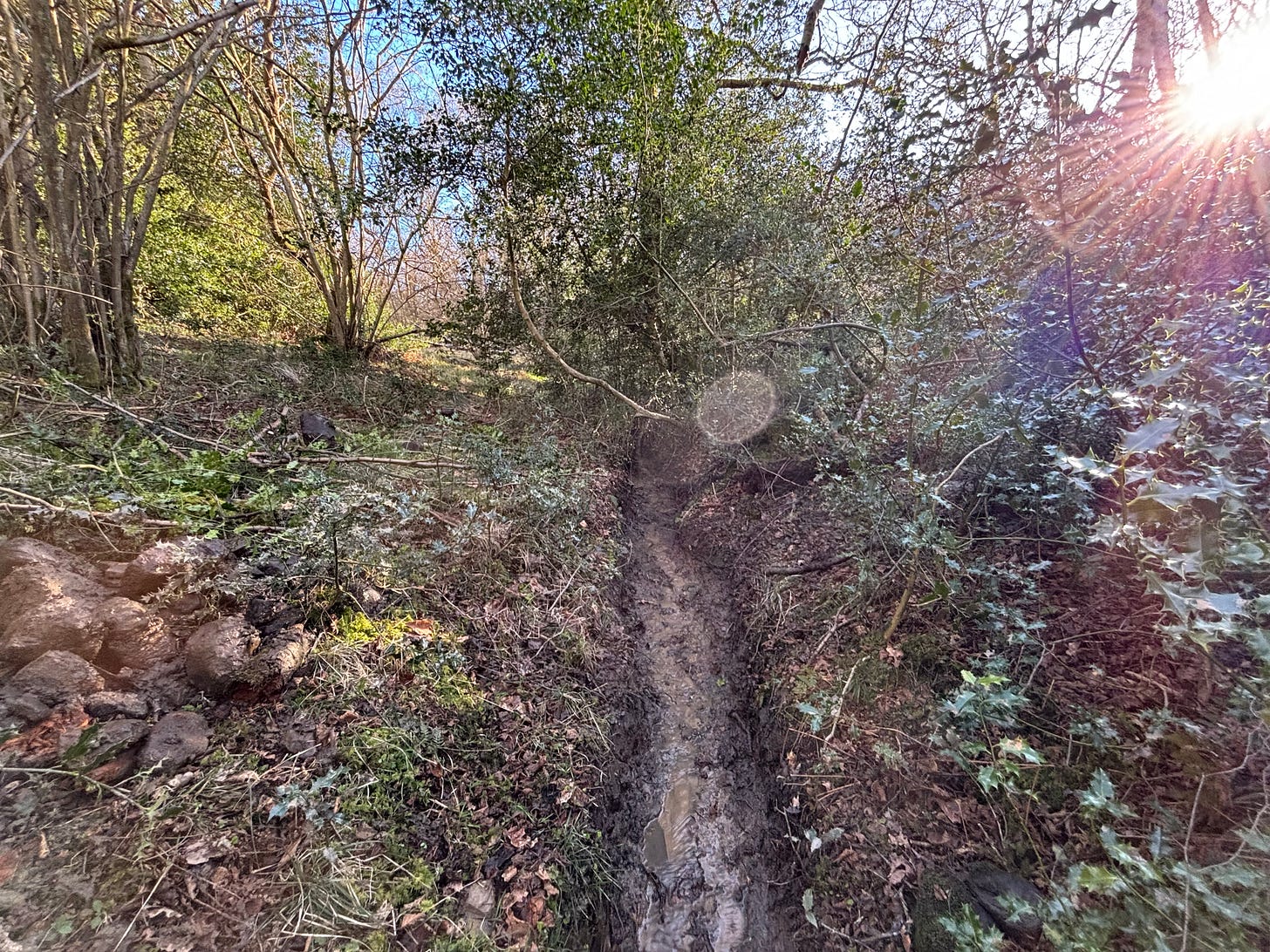
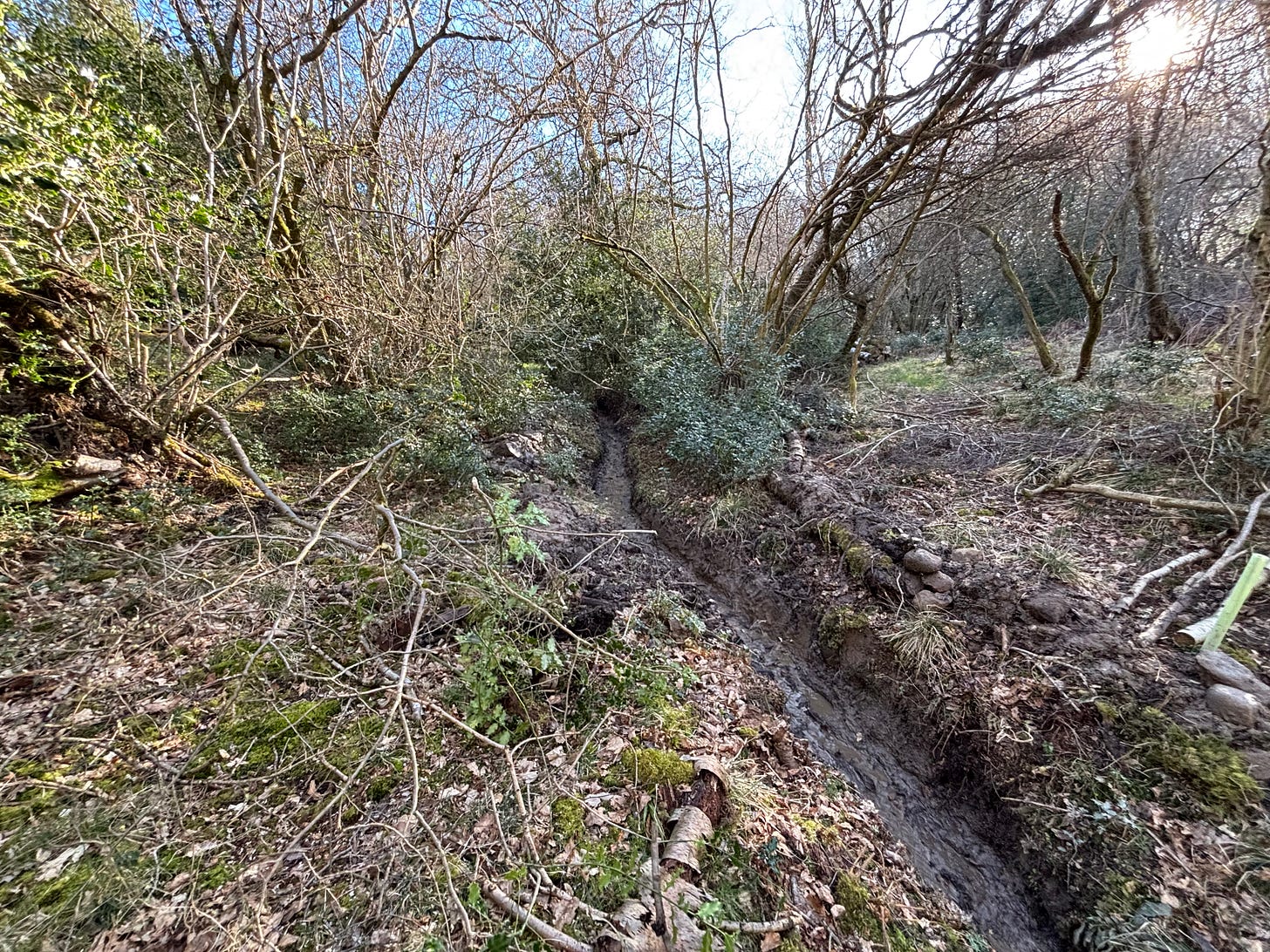
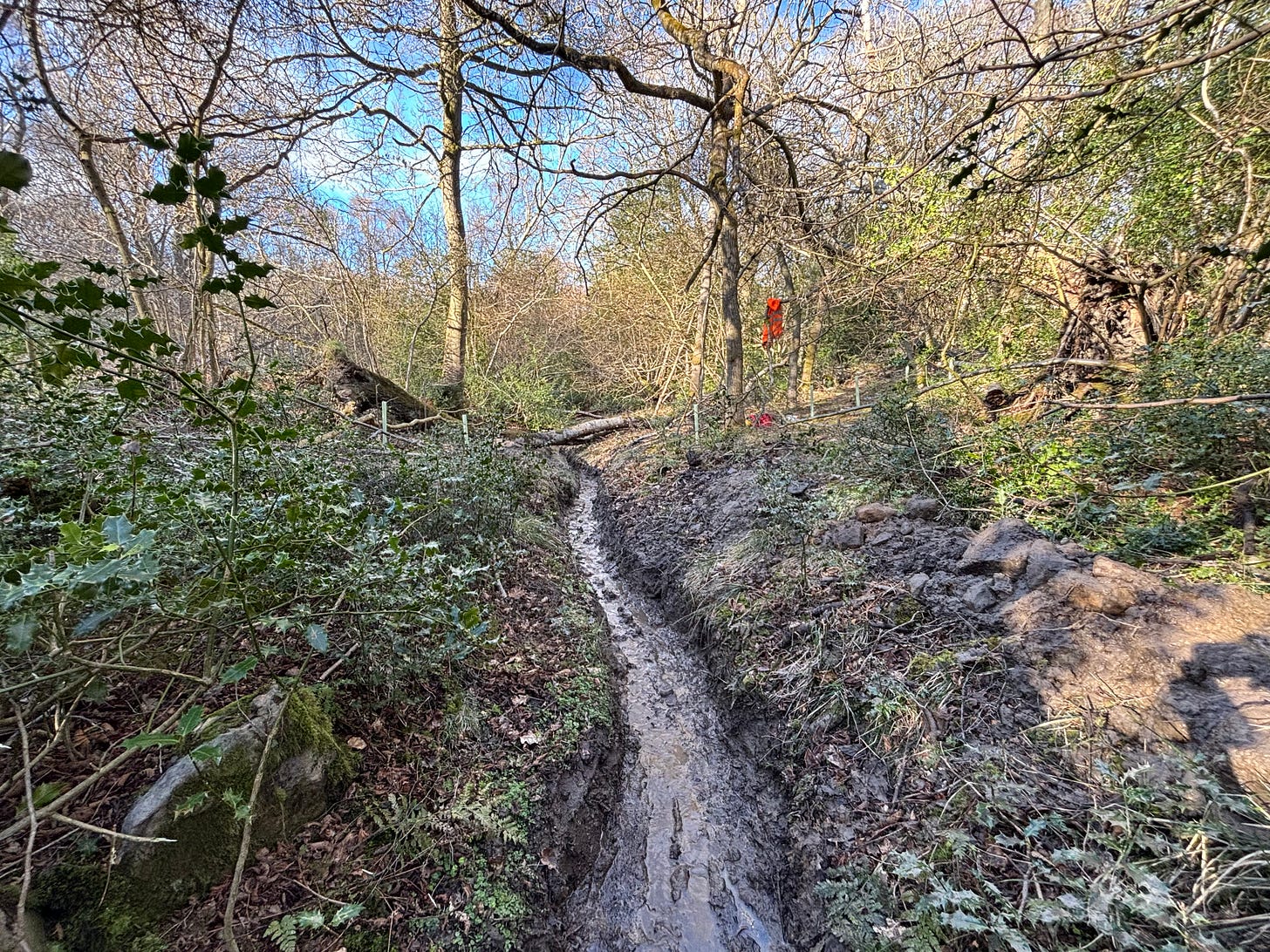
Another fun few days playing in the clarts…you must be in your element Jamie, keep it up…
I dig what you're doing with your forest and I really enjoyed reading this post -- it's an education in itself!
Strange thing is, I watched a video about drainage channels on YouTube just the other day. https://www.youtube.com/watch?v=IpxE1iPg_p8
Then again, I'm the sort of guy who watches videos of giant tunafish getting expertly butchered.
https://www.youtube.com/watch?v=IpxE1iPg_p8
What can I say? The world is a varied and very, very interesting place :-) The amount of things I know absolutely nothing about is ... overwhelming?
"... colonised by saprophytic fungi" I have no idea what that is but it sounds disgusting! (but also deliciously lesbian -- very confusing) Poor birch trees ...
" ... clicks through to the actual map" -- I clicked through, because I love maps. I don't have pictures but maps and sea-charts on my walls. I travel on Google Earth. I'm getting to know Newcastle and the Tyne because of you and David McGrogan who I also follow on Substack
https://newsfromuncibal.substack.com/p/state-of-contempt
Also: I recently found out that the Toy Dolls that we used to listen to when we were teenagers are from South Shields :-) https://www.youtube.com/watch?v=_SDvb3cjPQg
Strangely, I already knew a mattock from a pickaxe, but not a shovel from a spade. I read and learn. But thanks to the Shell Book of Country Crafts I can tell a coppice from a pollard at a glance. If that doesn't impress the girls, I don't know what will.
"... almost certainly a spring from an old mine shaft (there is a tell tale iron oxide in it)" Wha? Mine shaft under your woods? There's a brilliant Australian guy who's working hard on leveling up from the stone age to the iron age in real life, using iron oxide slimy mud from a creek: https://www.youtube.com/watch?v=dhW4XFGQB4o
Those pork pies look delicious -- a gem of a video!
"... drain into the burn" -- that's the same word for 'small river' (brook?) they use in Scotland?
"... prying out all of the large rocks (precious resource)" *muffled giggling in Norwegian* The forests I'm used to are different from the ones you have on your island. I remember your post about Ecological Succession; some of the earlier stages reminded me of home :-) Or, as I overheard an American tourist exclaim once: "It's all fuckin' rocks!" He wasn't onto nothing ... among ourselves, when no one is listening, we call our country 'the scree', the rock-slide. 2,2% arable land, the rest barren wilderness, fit only for goats and reindeer. But I digress ...
I'd love to come over and help you dig your ditches, but I've done my back in and the Guild would kick me out for doing agricultural work. Sorry!